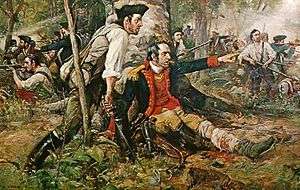Nicholas Herkimer

Nicholas Herkimer (Herchheimer; c. 1728 – August 16, 1777) was an American Patriot militia brigadier general during the American Revolutionary War, who died of wounds after the Battle of Oriskany.
Early life and career
Herkimer was the son of Palatine German immigrants Catherine Petrie and Johann Jost Herchheimer, from the parish of Leimen in the Palatinate.[1] He was born in the vicinity of German Flats in the Mohawk Valley of the Colony of New York, and was the elder brother of Loyalist Captain Johan Jost Herkimer. Nicholas was of slender build, dark complexion, black hair, and not quite six feet tall. He could speak German, English and Iroquois.
During the Attack on German Flatts in the French and Indian War, he was involved in its defense. He was made a captain in the militia on January 5, 1758, and he repelled a second attack on German Flatts in April of that year.
Herkimer built his new house in 1764 near the present-day city of Little Falls, New York on the south shore of the Mohawk. He used a number of slaves on his estate.[2]
American Revolution
In July and August 1775 Herkimer headed the Tryon County Committee of Safety, and became colonel of the district militia. After the split in which Loyalist militia members from the area withdrew to Canada, he became a brigadier general in the Tryon County militia by the Provincial Congress on September 5, 1776. In June 1776, he led 380 men of the Tryon County militia to confront Joseph Brant at Unadilla, New York. Herkimer requested that the Iroquois remain neutral while Brant said the Indians owed their loyalty to the King.
When Herkimer learned of the siege of Fort Stanwix to the west in late July 1777, he ordered the Tryon County militia to assemble at Fort Dayton. He then marched them out to Fort Stanwix, about 28 miles to the west. His force marching in column was ambushed on August 6 by a mixed force of British regulars, Tory militia, and Mohawk Indians in the Battle of Oriskany. Herkimer's horse was shot, and he was seriously wounded. In spite of his injuries, he had himself propped up against a tree, lit his pipe, and directed his men in the battle, rallying them to avoid two panicked retreats. When they withdrew they carried him home.
The brigade surgeon, William Petrie, dressed Herkimer's wound in the field and placed him on a litter. The wound quickly became infected, but the decision to amputate the leg was delayed for about ten days after the battle. The operation was performed by an inexperienced surgeon, Robert Johnson, because William Petrie was wounded in the battle and was not available. The operation went poorly, the wound bled profusely, and Herkimer died of the injury on August 16, at around the age of 49.
Legacy
Herkimer's home, in what is now Little Falls, New York, is preserved as the Herkimer Home State Historic Site. Herkimer County, New York was named in his honor.[3] His nephew, John Herkimer, later became a U.S. Congressman.
In popular culture
- Herkimer appears as a character in the 1939 movie Drums Along the Mohawk, starring Henry Fonda and Claudette Colbert. It is based on the 1936 historical novel by Walter D. Edmonds of the same name, about the colonial era and German settlements in the valley.
References
Notes
- ↑ Jones, Henry Z. Jr., Palatine Families of New York 1710; 1985, Vol. 1, p. 388
- ↑ Falk, Cynthia G. "Forts, Rum, Slaves, and the Herkimer’s Rise to Power in the Mohawk Valley," New York History, 89 (Summer 2008), 221–34.
- ↑ Gannett, Henry (1905). The Origin of Certain Place Names in the United States. Govt. Print. Off. p. 155.
Further reading
- Foote, Allan D., "Liberty March - The Battle of Oriskany," North Country Books Inc., Utica, New York, 1998
External links
| Wikimedia Commons has media related to Nicholas Herkimer. |
- Herkimer Home State Historical Site
 "Herkimer, Nicholas". Appletons' Cyclopædia of American Biography. 1892.
"Herkimer, Nicholas". Appletons' Cyclopædia of American Biography. 1892. Beach, Chandler B., ed. (1914). "Herkimer, Nicholas". The New Student's Reference Work. Chicago: F. E. Compton and Co.
Beach, Chandler B., ed. (1914). "Herkimer, Nicholas". The New Student's Reference Work. Chicago: F. E. Compton and Co.- Nicholas Herkimer at Find a Grave